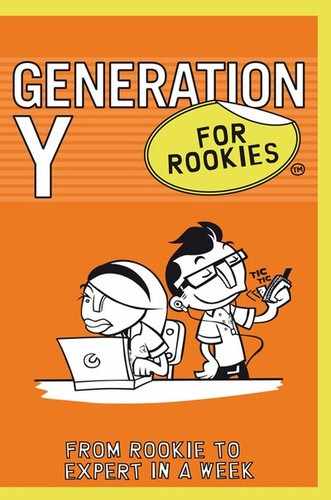CHAPTER 3
How to attract and
recruit the right Gen Ys
for you
What attracts Gen Y is different
from what attracted X-ers and
Boomers
Gen X were lured into a job by the prospect of being able to get on, by the pay and benefits and security. They are loyal to themselves and their career and wanted to see what their career ladder would look like before they joined a company.
Boomers looked for fulfilment and status, and they wanted to work for a company they could feel loyal to. They were building their careers in the days when working for one organization for life was the norm, when changing jobs every few years looked flighty, and when most organizations had long service awards – the assumption being that the longer you stayed with a company, the better it was.
Gen Y is looking for work that they will learn from, that will help them to grow and build their portfolio of knowledge. They want to do work that is meaningful to them, and they want to learn from their older colleagues.
It is important to remember these differences in values and attitudes if you are going to be able to attract Gen Y. They will not respond to the sorts of “lures” that X-ers and Boomers respond to.
 Rookie Buster
Rookie Buster
Gen Y is looking for work that they will learn from, that will help them to grow and build their portfolio of knowledge.
What doesn’t attract Gen Ys at all
(but companies still put on their
“benefits” list)
Many companies carry on acting as though what attracted people twenty years ago will attract them today. Either it doesn’t occur to them that the different generations want different things, or they are hoping against hope that by telling people that what they have to offer really are benefits, their potential hires will be convinced.
Here are the most common benefits I see in job advertisements that really don’t attract Gen Ys (apart from those who are more like Gen Xs and so go for the more traditionally run sectors):
• Pension schemes.
• Company cars (especially uninteresting to Gen Ys working in cities).
• Childcare/childcare vouchers.
• Eye test vouchers (scraping the bottom of the barrel, this one – even if they wear glasses, will they really see this as a benefit?).
• Share schemes (may be interesting to the few twenty-somethings who will trade cash for savings).
What does attract Gen Y
Some of the benefits that Gen Y really do see as benefits are not as costly as some of the items listed above. Perhaps senior managers assume for that reason that they are not valued benefits. They include:
• Interest-free travel loans (especially valued in big cities).
• Interest-free loans for bicycle purchase (great for cities and for those who care about the environment).
• Gym, or gym membership paid.
• Personal development and training.
• A good manager or mentor (this is extremely high on the list for many Gen Ys – they really want to learn from their older colleagues).
• A chance to try other jobs or learn new things via a job-rotation scheme.
• Flexible working hours so that they can keep up their other hobbies and interests.
It would be a good idea to put benefits on your website – but put them all, not just the ones that the senior managers consider to be a valuable benefit. The younger generation may value a lot of what you can offer, but they need to know about it.
Some companies hardly mention the benefits of working with them at all, and merely say something like “You will receive the benefits that you would normally expect from a leading organization.” Apart from being plain lazy, that is such a missed opportunity to sell the company – after all, how are graduates supposed to know what benefits they can expect from a leading organization? Find out what your Gen Ys consider to be benefits – you may already be offering them, but just failing to tell people when you are trying to attract them. According to the talentsmoothie research, company websites are the most important source of information for graduates when they are looking for a job. So you need to make sure yours works hard for you. Think of the vacancies section of your website as an excellent marketing opportunity, and make it work for you.
 Rookie Buster
Rookie Buster
Find out what your Gen Ys consider to be benefits – you may already be offering them, but just failing to tell people when you are trying to attract them.
Recruiters’ biggest mistake
All the mistakes I mention in this chapter are of course a problem, but one of the biggest mistakes I see recruiters of Gen Y make is making promises they cannot deliver.
Some of them know that the promises made in the glossy brochures they give to candidates cannot be fulfilled. One of the most cited reasons for leaving a company within the first couple of years is that it wasn’t delivering on its promise and/or it wasn’t as good as it was made out to be during the recruitment process.
It is tempting to over-sell to get the right people in, but it is a short-term fix to a problem and will create other problems later. Sure, it is difficult if you know that the company culture will pose a problem to Gen Ys, and that they will find it stifling and old fashioned, as others have before them – but to pretend the company culture is different from what it is will not only lead to people leaving but could also damage your employer brand.
 Rookie Buster
Rookie Buster
To pretend the company culture is different from what it is will not only lead to people leaving but could also damage your employer brand.
So what can you do when you know that there are flaws in the company that might put off potentially good candidates? The most important thing is to be honest. That is not to say you have to criticize the company. Nor does it mean you have to regale candidates with what you believe to be problems about the company and its culture (for one thing, what you perceive as a problem may not be a problem to others). But you can answer questions honestly. For example, if a candidate asks you what the management style is like in the department you are recruiting for, you can answer that some people find it OK and others don’t. And you can genuinely add that to experience and learn to handle a range of different styles is a good learning opportunity. People can learn from having inadequate managers, if only to learn what not to do themselves.
You can also tell your candidate that one of the things you look for in new young recruits is the chance to change some of the more unhelpful parts of the current organizational culture.
As long as you honestly believe what you are telling them, you can turn a potential reason for them to turn down the job into a reason why they might take it. A 26-year-old who I mentor has recently taken a job in an organization with a very old-fashioned culture because he wants to build up his experience of implementing change in a tougher environment than the ones he has worked in before. When they hired him they were honest about the challenges and he consciously decided to go there because of these challenges. So be honest about the upsides and downsides (as you see them) of coming to work for your company. And remember that what you may regard to be a downside, others may not.
 Rookie Buster
Rookie Buster
Be honest about the upsides and downsides (as you see them) of coming to work for your company. And remember that what you may regard to be a downside, others may not.
The best selection methods for Gen Y
Current methods are biased
Current methods of attraction and recruitment can be inadvertently biased towards the older generations. That’s not surprising, because they were devised with those people in mind. The values, attitudes, approaches and skills-sets of the younger generation differ markedly from those of Boomers and Gen X. One of the ways that Gen Y differ from other generations is their tendency towards, and preference for, collaborative working. This is in large part due to their use of technology. The implications of this are changes in the way they work, communicate and learn.
Many organizations use competency frameworks to assess potential new recruits, but these changes in preferred ways of working may not be reflected in current competency frameworks and other assessment criteria. The majority of competency frameworks were devised by Boomers and X-ers, as were psychometric and other tests. Existing norm groups are of course made up of Boomers and X-ers. For many companies, competency frameworks and psychological tests play a crucial part in a number of HR processes, including selection and recruitment. However, the competency benchmarks that companies are judging their people against could be out of date or at least in need of examination in today’s context and in relation to the contemporary workforce. For example, norm groups of senior managers in large corporations are commonly used. The assumption is that these are good, or at least useful, comparators, and that the up-and-coming talent inside a company should aspire to be like those who are running companies today. Gen Y or no Gen Y, we need to re-evaluate what we want from our future leaders and whether what we want is the same as what we have now. That aside, current leadership styles are arguably still predominantly based on command and control. That is not to say that these styles are ineffective in some contexts. However, Gen Y are inherently more collaborative in their working style.

Selecting for out-of-date skills?
It’s a fair bet that when Gen Y are in charge of companies (and they are of the age where they are getting into junior and middle management positions already), the prevailing leadership style will be collaborative and enabling, not controlling and commanding. But many organizations are, perhaps unintentionally, judging a future generation of leaders against an outdated model, and thus perhaps mistakenly excluding good future leaders from their talent pool or high-flier development programmes.
Inevitably we look at the world through our own filters and from a standpoint of the prevailing paradigm. The dominant organizational/leadership paradigm for many years has been a hierarchical one that is based on the assumption that people need to be controlled and monitored. Evidence of this is the 9–5 working hours culture (flexible working is still not the norm – many companies struggle to trust their employees enough to manage outcomes rather than the process) and power-based organizational cultures. Gen Y want something different. They are a generation that has grown up with the internet and technology. They are used to having access to information and people via the internet and social networking sites. The world has become more democratic and transparent because of that, and this includes the world of work. They are less concerned about the hierarchy, and more concerned about getting to the right person, whoever that person may be. All this means that it is time to review the very assumptions and foundations upon which some existing attraction and recruitment approaches are based. If you are recruiting, you need to make sure that you are totally clear about what you are looking for – and that you are not just looking for the same as you have always looked for before out of habit.

 Rookie Buster
Rookie Buster
If you are recruiting, you need to make sure that you are totally clear about what you are looking for – and that you are not just looking for the same as you have always looked for before out of habit.
What should you be judging people on?
Companies typically judge potential hires solely on their ability to do the job. They may or not find out whether people actually want to do the job. They take this as a given. Ideally of course, those we hire really do want to do the job. But what we should in fact be finding out is whether they would love to do it. You need to select people who love to do the job, not those who are merely able to do it.
 Rookie Buster
Rookie Buster
You need to select people who love to do the job, not those who are merely able to do it.
Doing a job that you love to do plays to your strengths and leads to better performance as well as more satisfaction. Generation Y are much more attuned to this. They have typically been brought up to expect that they can aspire to doing a job that they love. HR people and managers have been well trained to focus lots of time and effort on figuring out people’s “gaps” and looking for their “development needs”. However, fantastic performers play to their strengths. Research shows that doing work that they love and playing to their strengths were the No. 1 factors in why graduates chose the employers they do, and in their motivation when they started work. Whilst Gen X might accept a job that they are 50 per cent happy with, Gen Y probably expect more than 80 per cent satisfaction from theirs.
It is nothing new that the best performers are those who have the capability to do the job as well as loving to do the job. All of us would prefer to have a job that we love to do, but Boomers and Gen X probably don’t expect that always to be possible.
Why do they need a degree?
I have had many conversations with graduate recruiters in which I have asked why they are restricting themselves to hiring people with 2:1s and above, and, in some cases, why the people they are hiring need a degree at all. I work with some super-bright non-graduates who are doing graduate level jobs or running their own enterprises.
Apart from some professions where the skills they learn in a degree are essential (medicine or architecture, for example), there is no good answer to that question. For most jobs, the degree the person has studied is probably unrelated to the job, and a degree is not an indicator of intelligence, nor is it an indicator of someone’s ability to do the job. So why do organizations insist on degrees? The real answer is that it makes their life easier. Asking for a degree is a bulk sifting mechanism: it screens out hundreds of other people (some of whom might be superb hires) and so cuts down the number of applications someone has to read. It’s as simple as that.
I work with some super-bright, committed non-graduates. One of them, Lamorna, you can read about below. Another passed the aptitude tests to get into a software development company that almost exclusively employs graduates from Oxford and Cambridge universities, and another is 23 and has worked his way up from a call centre job to UK sales manager since he started work. There are many talented young people out there, but companies miss out on them because of their fixation with degrees.
 Rookie Buster
Rookie Buster
There are many talented young people out there, but companies miss out on them because of their fixation with degrees.
Of course some sort of bulk sifting mechanism is needed. The first step is to be clear about the sort of person that you want to hire. Then you can devise a bulk, online set of questionnaires testing for the characteristics you want – you may want an intelligence test, an emotional intelligence assessment and a strengths assessment. The sifting can be automated according to your needs. Rather than restricting your recruitment to the country you are in, this means you can go global in your recruitment and therefore massively extend your potential pool of candidates. In the future, when talent shortages really start to bite, this will be the only way to ensure that you get the up-and-coming workforce you need.
Lamorna is an example of someone very bright who did not get into university and could not get a graduate level job as a result. She eventually landed a job for a big, high-profile sports sponsorship organization: only later did she find out that the boss of this organization had not wanted to hire her as he thought she was too young to be able to handle the responsibility of coordinating high-risk sporting events and handling the not uncommon crises that occurred. At last she had an opportunity to prove herself. She quickly found her feet, did an excellent job and after a couple of years was poached by the competition. Incidentally, the boss who had been so against her appointment became her biggest fan and remains so.
At this stage she was still only 21, and by now had a lot of experience under her belt, a good network of contacts and ever-increasing confidence. She started applying for graduate level jobs again, but found that she could not even get through the online process, because if you don’t complete certain sections of the form you cannot move into the following sections.
By this time she had acquired many skills and lots of experience, and she had a clear idea of where her strengths lay. And she was ready for her next big work challenge. She is a determined person and she pointed out to some of the companies that she was probably a better prospect than some graduates, as she had a number of years’ experience in demanding jobs, had acquired a whole load of useful expertise “and could provide stellar references”. However, she still could not get through their process, and even when she determinedly badgered prospective employers with phone calls, no one would even give her a chance. So she decided to set up a social enterprise organization with a friend. At the time of writing, the enterprise is two years old and this year they are on target to raise £1.2 million for charity. Both the organization and the young women have won a number of awards, and she is now on demand on the speaker circuit.
Clearly the organizations she approached missed out on a very talented individual because of their screening process. Think about what is really important for the job you are offering: is a degree really necessary? By being really clear about what you need, you can target excellent hires much more precisely. Excuse the analogy, but why use a blunderbuss to hit a moving target if you can use a high-powered sniper rifle instead?
Interviewing Gen Ys
Until fairly recently, recruiters mainly focused on finding out why they should be employing the person sitting in front of them for the job. These days it’s much more of a two-way process. The balance of power has shifted. Good candidates are keen on checking out not just what they can do for a company, but what a company can do for them. And that’s fair enough. Really good employees deserve a fair exchange for their time, labour, knowledge and skill.
Gen Y ask all sorts of questions at interview that their older coworkers might want to ask but would never dream of actually saying. Questions like:
• What development will you give me?
• Which latest technologies will I have access to at work?
• What support will my manager give me in my job?
• Why do I have to work from 9 to 5.30? I like to work from home sometimes and the technology allows it.
• I have a hobby that’s important to me, and I will need to take some afternoons off to travel, but will make up the work at the weekends. Is that OK?
 Rookie Buster
Rookie Buster
Gen Y ask all sorts of questions at interview that their older co-workers might want to ask but would never dream of actually saying.
I recently spoke to a recruiter from a company in an industry that is not perceived to be particularly appealing to graduates. She was telling me what trouble they were having hiring good engineering graduates. That week, however, one of their preferred candidates had accepted a job with them. They were delighted, but then the candidate rang to say he was a musician as well as an engineer and he needed time to rehearse, so could he renegotiate his contract to a four-day instead of a five-day week. The company in question were appalled that he should ask such a thing and said no. So basically they could have had a good person for four days a week, but ended up not having him at all. Companies are going to have to start being more flexible and imaginative in their approach to hiring, because it is becoming more and more likely that the good people will start to make such requests!
Coach’s notes 
• Find out what your target recruits value as benefits, and put them on your website.
• Use technologies such as chatrooms and blogs that allow candidates to have a dialogue with you about the opportunities, what your organization is like, etc.
• Make sure you are hiring what you really need for today’s world and tomorrow’s world too – don’t keep unquestioningly hiring the same types of people.
• Don’t assume that all generations want the same benefits – different benefits appeal to different generations (and of course there is variation within the generations too).
• Move on from asking “Can they do the job?” and ask “Can they do the job and will they love to do it?” Ask them what they love doing and what they are passionate about. Observe their body language when they are talking to you – passion shows. Hiring for passion as well as competence will bring you the strongest candidates.
• Think about any “restrictive” working practices you have that may put Gen Y off – for example, why do they have to work 9 to 5? Employers who can be more flexible will have their choice of more candidates.
• Really listen to the questions the candidates are asking at interview. They are clues to the sorts of things you can do to make your organization more attractive to good people.
• Think about what skills are needed to take your organization forward – skills like collaborative working, listening well and building trusting relationships and the ability to network well.
Go for it! There are many great Gen Y candidates out there, but because of the ageing global population, they will be in greater and greater demand (even taking account of graduates from India and China). You will be able to compete well for the best talent if you simply take a look at some of your hiring practices and make the simple changes suggested in this chapter.
It doesn’t actually take much to get a reputation as a forward-thinking organization. It’s amazing how a few small steps can take you to a position of being “best in class”.

Notes |

